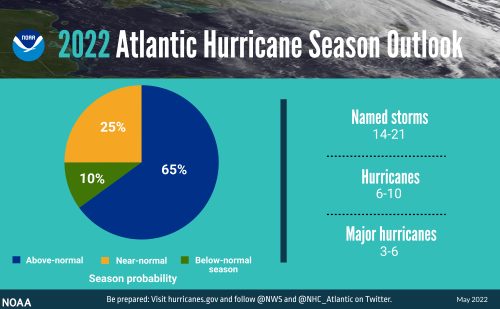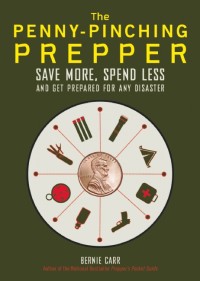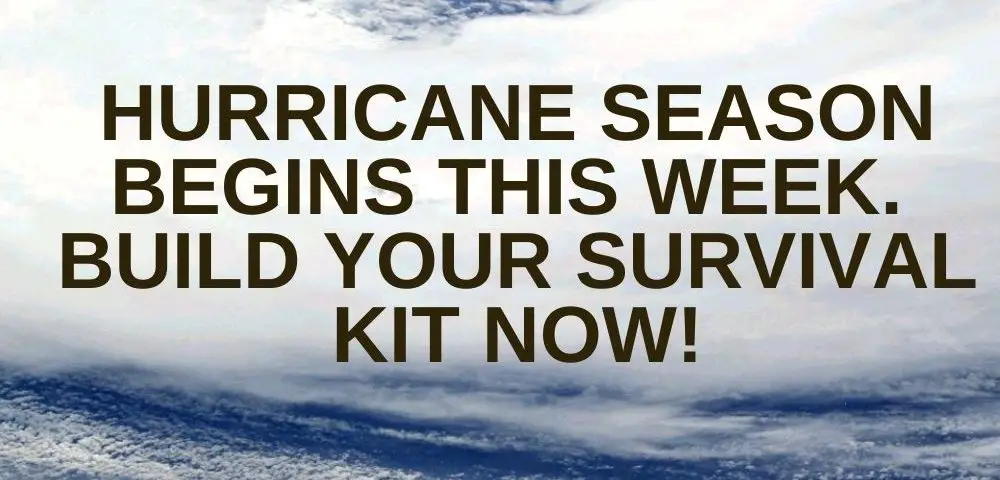Written by Bernie Carr
A new hurricane season is already upon us. Hurricane season started yesterday (June 1 – November 30). The National Oceanic and Atmospheric Administration (NOAA) is predicting an above normal hurricane season for 2022, making it the seventh consecutive above average hurricane season.
NOAA is forecasting a range of 14 to 21 named storms (winds of 39 mph or higher), of which 6 to 10 could become hurricanes (winds of 74 mph or higher), including three to six major hurricanes (category 3, 4 or 5; with winds of 111 mph or higher). NOAA provides these ranges with a 70% confidence.

If you live in a hurricane-prone area, now is the time to build your survival kit. Going shopping the day before a hurricane is expected can be a nightmare which you’ll want to avoid.
You have a couple of options: make your own OR buy a pre-assembled survival kit. You also need to decide how much money and how much time you want to spend.
Factors to consider:
- Number of people in your household
- Number of days you are covering
- Type of emergency
- Purpose of the kit – home emergency, car emergency etc.
Whatever kit you choose, there will be some crossover – some of the same items would be useful regardless what type of disaster- power outage, hurricane, earthquake, flood etc.
What to include in your 72-hour kit
Food – Include food that does not need a lot of effort to prepare: energy bars, canned food, “just add water” meals (dehydrated or freeze dried foods), crackers, etc. Include some comfort food such as chocolate, candy, and chips. Don’t forget the manual can opener! Keep a mini one on your keychain just in case.
Water – One gallon per person per day is the guideline
First aid – in addition to the basic first aid contents, include personal prescriptions, eyeglasses, contact lenses etc. It is also a good idea to include a pocket first aid manual.
Communications – battery operated or crank weather radio, charged cell phone, extra phone chargers (check out ways to charge your phone when the power is out here.)
Personal hygiene – toilet paper, trash bags, moist towelettes
Lighting, Fire and warmth – flashlights, propane or other alternate fuel stove, candles
Basic tools such as knife, multi-tool, wrench, and pliers.
Entertainment – books, board games, cards
You’ll also need to include other miscellaneous items such as stuffed animals for children, special needs, pet food, and medicines etc. While you’re in the planning mode, device a plan on what you will do if you need to evacuate the area. During a major hurricane, sudden flooding can occur even in areas that are not in a known flood zone.
If you decide to buy a prepackaged survival kit, go through the contents as soon as you receive it, so you know what you have stored up. Whether you are buying or assembling your kit yourself, now is the time to get started.
About the author:
Bernie Carr is the founder of Apartment Prepper. She has written several books including the best-selling Prepper’s Pocket Guide, Jake and Miller’s Big Adventure, The Penny-Pinching Prepper and How to Prepare for Most Emergencies on a $50 a Month Budget. Her work appears in sites such as the Allstate Blog and Clark.com, as well as print magazines such as Backwoods Survival Guide and Prepper Survival Guide. She has been featured in national publications such as Fox Business and Popular Mechanics. Learn more about Bernie here.
For more tips on prepping on a small budget, read my book:




I would add record all you cell phone numbers in a notebook. So if you need to use someone else phone you have the numbers.
Hi oldguy, Good idea-I keep my contact numbers in a small notebook. Thanks!
FEMA is now recommending to Puerto Rico residents that they stockpile for 10 days.
It is better to have more days than recommended, just need to start somewhere and build from there. Thanks for comment Suzanne!
I add to my survival kit a good helmet, safety boots, a prybar, a hammer, paracord and so ..